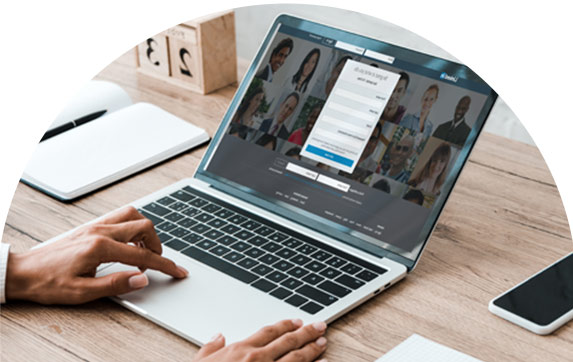LinkedIn is a platform that’s designed to bring people together. When it comes to business networking and lead generation, there are few better options. Among its many tools and options for helping people connect are things like direct requests and sponsored InMail (now Message Ads), but which is best for generating new leads? We take a look in more detail about whether to send InMail vs connect directly to find out which is better for salespeople.
An introduction to InMail and Connection Requests
To determine whether you should send InMail vs connect directly, let’s start by looking at what these two key terms mean. As we’ll see, although both help people make new connections and grow their network, there are some pretty significant differences.
What is InMail?
Sponsored InMail is LinkedIn’s premium messaging service. Essentially, they are promoted messages that allow you to target other LinkedIn users based on a whole host of demographics.
The tool is one of many that come with LinkedIn’s premium account. This range of tools makes it easier to do things such as sending connection requests, managing your network, and creating a consistent source of leads.
Recently, LinkedIn changed the name of its InMail service to Message Ads. However, many experts in the industry still use the term sponsored InMail, which is why we’ve used both.
What is a connection request?
A LinkedIn connection request is essentially an invitation to connect on the platform. You can send these to a variety of people based on your existing network. Essentially, if you send one to someone and they accept, they’ll list among your 1st-degree connections.
For regular LinkedIn members, this is the primary way of expanding your reach on the platform. You can build connections with all kinds of peoples and accounts, and the platform gives you several ways to connect with others.
You don’t need to have a LinkedIn Premium account to use the connection request feature, which makes it the ideal tool if you’re just starting out.
InMail vs Connection Request Head-to-Head Features
Both of these methods of connection have their own pros, cons, and features. As such, it can be challenging to know which is the best for expanding your network and generating new leads. For example, using InMail for lead generation can certainly be beneficial, but only if you know what you’re doing.
To make things clearer, we’ve broken down the key features of both standard connection requests and Message Ads:
Connection Requests
As we’ve established, connection requests are invitations to another LinkedIn member to join your network. Once they’ve accepted your request, they become a 1st-degree connection. Here are some of the main features of this method or connecting:
- Can reach out directly to 2nd- and 3rd-degree connections in your network.
- Quick and easy to do.
- LinkedIn has a ‘Grow Your Network’ page, giving you a consistent flow of new connections.
- If you have their email address, you can connect directly.
- You can search for people and profiles you already know.
As you can see, that’s a fairly solid set of features. What’s more, anyone with a LinkedIn account can access connection requests, meaning you don’t have to upgrade your membership.
InMail/Message Ads
As part of LinkedIn’s premium features, you can use Sponsored InMail to reach all kinds of people and profiles and the platform. It’s an effective tool, although there are limits on how many you can use. Here are some of the things that make it such a powerful tool:
- Targeted messages. You don’t have character limits or other restrictions. You can target your InMail to the people who are most likely to benefit from it, using the many search tools.
- Stronger engagement. By using this type of message, you can cut through the noise in the person’s inbox.
- You can send an InMail to anyone on LinkedIn, meaning you’re not restricted to people already in your network.
- LinkedIn also offers many tools and metrics that support InMail/Message Ads.
These are some incredibly useful features, making it easy to generate leads. You can also see things like read receipts to make sure your message is reaching the right people. Of course, all this requires a LinkedIn Premium account.
Standout Features
So, now that we know how InMail and connection requests work and what some of the main features are, it’s time to look at whether to send InMail vs connect requests when you’re trying to generate leads. To do so, we’ll compare some of the features to see which is most worth it for you.
The main differences between InMail and a Connection Request
Let’s look at a few of the main features and how they differ:
- Price. Connection requests are free, whereas InMail costs. You’ll need a Premium membership, which costs anywhere from $29.99 to $119.95 per month.
- Reach. With a standard connection request, you can only reach those people already in your network. InMail lets you message anyone who is on the platform.
- Limit. You can send as many connection requests as you like, while InMail credits are limited. Depending on your subscription, you get 15-60 per month, but you can buy more InMail credits.
- Effectiveness. Standard requests are a little hit and miss depending on who you try and connect with. Due to their targeted and stand-out nature, LinkedIn claims that InMail recipients have an open rate of 50%, which is very strong.
- Extra tools. You don’t really get any extras with the standard connection. However, LinkedIn Premium gives you all kinds of analytics tracking and insights to measure how well your InMail is performing.
Final thoughts
Clearly, both of these tools are useful. When it comes to generating leads, both are pretty essential. For the more targeted work, InMail presents a unique opportunity. However, InMail credits are limited, and you’ll need a Premium Sales Navigator account to access them. On the other hand, connection requests are free; they’re just limited in who you can reach with them. Hopefully, that helps you when deciding if send InMail vs connect directly is the right approach for you.
FAQs
Below, we’ve answered some of the top questions about InMail:
Can you receive InMail without Premium?
Yes, you can send an InMail to anyone on the platform, even if they don’t have a Premium account. This only applies if you pay, however.
When would you not get an InMail credit back?
You receive an InMail credit for every message that receives a response within 90 days of sending. However, those that don’t get a response won’t get credited back.
How do you see how many InMail credits you have left?
All you need to do is first navigate ‘Access My Premium’ from your icon and then select ‘InMail’ to see the number of credits.
Can you tell if someone read your InMail?
If both you and the recipient have read receipts turned on, you’ll be able to see whether your message has been read.

